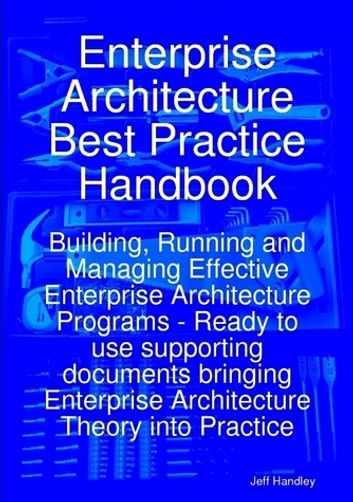| FindBook |
有 1 項符合
Enterprise Architecture Best Practice Handbook: Building, Running and Managing Effective Enterprise Architecture Programs - Ready to use supporting documents bringing Enterprise Architecture Theory into Practice的圖書 |
 |
Enterprise Architecture Best Practice Handbook: Building, Running and Managing Effective Enterprise Architecture Programs - Ready to use supporting documents bringing Enterprise Architecture Theory into Practice 作者:Jeff Handley 出版社:Emereo Publishing 出版日期:2012-10-24 語言:英文 |
| 圖書館借閱 |
| 國家圖書館 | 全國圖書書目資訊網 | 國立公共資訊圖書館 | 電子書服務平台 | MetaCat 跨館整合查詢 |
| 臺北市立圖書館 | 新北市立圖書館 | 基隆市公共圖書館 | 桃園市立圖書館 | 新竹縣公共圖書館 |
| 苗栗縣立圖書館 | 臺中市立圖書館 | 彰化縣公共圖書館 | 南投縣文化局 | 雲林縣公共圖書館 |
| 嘉義縣圖書館 | 臺南市立圖書館 | 高雄市立圖書館 | 屏東縣公共圖書館 | 宜蘭縣公共圖書館 |
| 花蓮縣文化局 | 臺東縣文化處 |
|
|
The book starts with an initial strategy that is focused on planning Enterprise Architecture services that are completely aligned to requirements and are based on a mission statement. This business-oriented approach is refreshing and will keep IT grounded in the real reasons for Enterprise Architecture. More importantly is the process for careful selection of services to provide. An overly ambitious set of service goals will kill a Enterprise Architecture implementation early in its life by offering too much before there is stable Enterprise Architecture in place. This book is realistic and lays the foundation for a successful implementation.
The section on the actual design of the Enterprise Architecture structure provides insights and information that can be applied to a large number of solutions. Since Enterprise Architecture will be organized in accordance with requirements and unique mission statements, this section of the book is like a catalog of patterns. It has excellent tips on how to best structure Enterprise Architecture to meet requirements and mission. The information on accurately estimating staffing requirements is consistent with industry best practices and something that, believe it or not, is often overlooked when Enterprise Architecture is established.
This book gets into the meat by thoroughly covering the processes that are essential to running Enterprise Architecture. There are many topics that stand out as both unique [to books of this genre] and reflect best practices by the best-run Enterprise Architecture shops. Examples are change control, disaster recovery and vendor management. These topics show that the author not only considers business alignment, but also cross-functional alignment.
Professional resources and underlying technology are provided in detail.
This book contains an in-depth coverage of operational requirements for Enterprise Architecture once it has been implemented. It hits all of the critical success factors, such as performance metrics, service level agreements, communications and internal evaluations.
You will find this book to be one of the best for planning and implementing a world-class Enterprise Architecture program.
|











